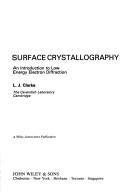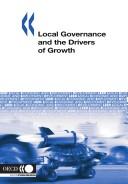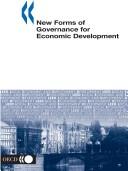| Listing 1 - 10 of 30 | << page >> |
Sort by
|
Book
Year: 1978 Publisher: Boulder : University of Colorado,
Abstract | Keywords | Export | Availability | Bookmark
 Loading...
Loading...Choose an application
- Reference Manager
- EndNote
- RefWorks (Direct export to RefWorks)
LEED (DIFFRACTOMETRY) --- PHOTON --- SCATTERING --- LEED (DIFFRACTOMETRY) --- PHOTON --- SCATTERING
Book
ISBN: 3540113975 0387113975 3642474993 3642474950 9783540113973 Year: 1982 Volume: 20 Publisher: Berlin : Springer,
Abstract | Keywords | Export | Availability | Bookmark
 Loading...
Loading...Choose an application
- Reference Manager
- EndNote
- RefWorks (Direct export to RefWorks)
Surface chemistry. --- Solid state chemistry. --- ELECTRON MICROSCOPY --- DIFFRACTION --- ADSORPTION --- PHOTOELECTRIC EMISSION --- PHOTOELECTRON SPECTROSCOPY --- LEED (DIFFRACTOMETRY) --- ENERGY LEVEL --- MASS SPECTROMETRY --- CHEMISORPTION --- FLUORESCENCE --- AUGER
Book
ISBN: 0852744501 Year: 1987 Publisher: Bristol : Adam Hilger,
Abstract | Keywords | Export | Availability | Bookmark
 Loading...
Loading...Choose an application
- Reference Manager
- EndNote
- RefWorks (Direct export to RefWorks)
Solid state physics --- Solid state physics. --- INORGANIC COMPOUNDS --- CRYSTAL STRUCTURE --- CHARGE DENSITY WAVE --- LEED (DIFFRACTOMETRY) --- GRAIN BOUNDARIES (CRYSTALS) --- SEMICONDUCTOR MATERIALS --- LIQUIDS --- PROPERTIES

ISBN: 0471905135 9780471905134 Year: 1985 Publisher: Chichester : John Wiley,
Abstract | Keywords | Export | Availability | Bookmark
 Loading...
Loading...Choose an application
- Reference Manager
- EndNote
- RefWorks (Direct export to RefWorks)
Low energy electron diffraction --- Crystallography --- Crystallography. --- Low energy electron diffraction. --- Surface chemistry. --- Surface chemistry --- Chemistry, Surface --- Interfaces, Chemistry of --- Surface phenomena --- Surfaces (Chemistry) --- Chemistry, Physical and theoretical --- Capillarity --- Surface energy --- Surface tension --- Surfaces (Physics) --- LEED (Solids) --- Electrons --- Leptology --- Physical sciences --- Mineralogy --- Diffraction --- Leed (diffractometry) --- Scattering
Book
ISBN: 1282330101 9786612330100 0080958591 1856176916 9781856176910 Year: 2009 Publisher: Burlington, MA : Elsevier,
Abstract | Keywords | Export | Availability | Bookmark
 Loading...
Loading...Choose an application
- Reference Manager
- EndNote
- RefWorks (Direct export to RefWorks)
Adopted in the United States and a number of other countries, LEED? certification is the recognized standard for measuring building sustainability. Achieving LEED? personal certification or project certification is the best way to demonstrate that the project is truly ""green."" Written by an architect with over 30 years of international experience, this book provides architects, designers, building owners, and construction engineers with an easy to understand guide to the nuts and bolts of LEED? project and personal certification. Written in plain and easy to understand language, thi
Sustainable buildings --- Leadership in Energy and Environmental Design Green Building Rating System --- Design and construction --- Standards --- Examinations --- LEED Green Building Rating System --- LEED Rating System --- Ecologically sustainable buildings --- Environmentally sustainable buildings --- Green buildings (Green technology) --- Buildings --- Sustainable development --- Environmental Sciences --- Sustainable Development

ISBN: 1280357339 9786610357338 926401330X 9264013296 Year: 2005 Publisher: Paris : OECD,
Abstract | Keywords | Export | Availability | Bookmark
 Loading...
Loading...Choose an application
- Reference Manager
- EndNote
- RefWorks (Direct export to RefWorks)
Innovation, skills, entrepreneurship and social cohesion are key drivers of growth, and essential goals of effective economic development strategies. Each has a strong governance component, which requires real partnership between government, business and civil society. In this book, the OECD has brought together top world experts to translate policy lessons into concrete recommendations that will help policy makers and practitioners make the best governance decisions to stimulate growth.
Decentralization in government. --- Economic development -- Political aspects. --- Local Economic and Employment Development (Program). --- Local government -- Economic aspects. --- Local government --- Economic development --- Economic aspects. --- Political aspects. --- Local Economic and Employment Development (Program) --- Centralization in government --- Devolution in government --- Government centralization --- Government decentralization --- Government devolution --- Local administration --- Township government --- LEED Programme --- Organisation for Economic Co-operation and Development. --- OECD LEED Programme --- Local Economic and Employment Development Programme --- Political science --- Central-local government relations --- Federal government --- Public administration --- Subnational governments --- Administrative and political divisions --- Decentralization in government --- Local Initiatives for Employment Creation (Program) --- Administration locale --- Décentralisation administrative --- Développement économique --- Aspect économique --- Aspect politique
Book
ISBN: 9781568988856 1568988850 Year: 2010 Publisher: New York, NY : Princeton Architectural Press,
Abstract | Keywords | Export | Availability | Bookmark
 Loading...
Loading...Choose an application
- Reference Manager
- EndNote
- RefWorks (Direct export to RefWorks)
Since its launch in 1993 by the nonprofit U.S. Green Building Council, the Leadership in Energy and Environmental Design (LEED) program has become the standard measure of sustainability for buildings worldwide. Successfully reaching one of four LEED certification levels-Certified, Silver, Gold, or Platinum-requires specific point totals, which differ among building types. Getting certified, in addition to altruistic benefits, allows building owners to take advantage of a growing number of state and local government incentives. The menu of potential points available for various practices ranges from installing bike racks on-site to documenting the source of the iron ore used in anyconstruction steel. As any architect or developer can attest, navigating this complex system of required prerequisites and credits can be maddening. It may be good to be green, but it's still far from easy. An architect's knowledge of materials can make or break a building's rating. Though LEED's performance-based criteriaexclude individual materials and products from earning points toward certification, their specific use can. Apply a material in the wrong situation and you may not get credit for it. Fortunately, with a little insider knowledge, you can also use one material to get credit in two, three, or even more areas. LEED Materials is packed with critical information on nearly two hundred materials, products, and services. Organized in the Construction Specifications Institute (CSI) MasterFormat-industry standard in building contracts-this highly visual guide makes sure your material choices and uses will maximize your LEED credits. LEED Materials includes a foreword by Steven Winter, former chairman of the U.S. Green Building Council.
69.02 --- 745.5 --- materialenkennis --- designmaterialen --- ecologisch bouwen --- ecologische bouwmaterialen --- bouwen - constructie-elementen, duurzaam bouwen --- designmaterialen - algemeen --- Construction --- Construction durable --- Éco-produits --- Building materials --- Green products --- Leadership in Energy and Environmental Design Green Building Rating System. --- Sustainable construction. --- Matériaux --- Aspect environnemental --- Leadership in Energy and Environmental Design Green Building Rating System --- Sustainable construction --- duurzaam bouwen --- Green construction --- Building --- Sustainable engineering --- LEED Green Building Rating System --- LEED Rating System --- Sustainable buildings --- Earth-friendly products --- Environmentally safe products --- Commercial products --- Green marketing --- Recycled products --- Architectural materials --- Architecture --- Building supplies --- Buildings --- Construction materials --- Structural materials --- Materials --- Design and construction --- Standards --- Éco-produits --- Matériaux
Book
ISBN: 9789044737608 Year: 2013 Publisher: S.l. Deltas
Abstract | Keywords | Export | Availability | Bookmark
 Loading...
Loading...Choose an application
- Reference Manager
- EndNote
- RefWorks (Direct export to RefWorks)
Met veel inlevingsvermogen en niet gebonden aan een geloofsovertuiging beschrijft Petra Franke in dit boek de zeven wegen om het verlies van een dierbare te verwerken. Ze vertelt over de helende kracht van de tijd, over rituelen die het afscheid gemakkelijker maken, over het doorstaan van heftige gevoelens, over de kracht van dankbaarheid, over het omgaan met herinneringen en schuldgevoelens, en over het vinden van nieuwe levensmoed. Het verloop van de rouwperiode wordt op deze manier helder uitgelegd, met een duidelijk begin en einde. Als het verdriet een plaats heeft gekregen in uw leven, volgt het afscheid van de pijn en de wil om het leven weer te omarmen.
Chagrin --- Deuil (Psychanalyse) --- Deuil (Psychologie) --- Deuil causé par une perte --- Grief --- Leed --- Loss (Psychology) --- Perte (Psychologie) --- Perte [Deuil causé par une perte ] --- Rouw om een verlies --- Rouwen om een verlies --- Travail du deuil --- Verdriet --- Verlies (Psychologie) --- Verlies [Rouw om ] --- Rouw / rouwverwerking
Book
Year: 2022 Publisher: Basel MDPI - Multidisciplinary Digital Publishing Institute
Abstract | Keywords | Export | Availability | Bookmark
 Loading...
Loading...Choose an application
- Reference Manager
- EndNote
- RefWorks (Direct export to RefWorks)
This Special Issue on “Business Models and Sustainable Development Goals (SDG)” presents five research studies that examine transformative business models designed to support the United Nations SDG Agenda for 2030. The studies examine SDGs from the firm to national levels. Every organization has a business model that defines how the organization is designed to function. It is the engine that powers an organization, defining the value proposition of the venture, how it balances resources with the ecosystem where it operates, and how it generates cash flow and creates value. Changes to an organization’s business model are recognized as a fundamental approach to implementing innovations for sustainability. The capability to transform or transition to new business models is an important source of competitive advantage, providing leverage to improve the performance of an organization. A sustainable business model includes pro-active management, monetary and non-monetary value for a broad range of stakeholders, and takes a long-term perspective. A sustainable business model is where change, success, and hope for our planet’s future rests.
sustainable development goals (SDGs) --- sustainability --- sustainable development --- project success --- infrastructure project --- strategy --- public management --- sustainable business model canvas --- sustainable business model archetype --- materiality matrix --- winery --- agri-food sector --- information technology --- enterprise --- business model --- business sustainability --- sustainable business model --- IT --- IS --- BM --- SBM --- green buildings --- LEED certification --- real estate development process --- drivers of sustainability --- incumbents --- sustainability transitions --- transitioning economy --- case of Lithuania --- n/a

ISBN: 1280171588 9786610171583 9264015329 9264015302 Year: 2004 Publisher: Paris : OECD Publishing,
Abstract | Keywords | Export | Availability | Bookmark
 Loading...
Loading...Choose an application
- Reference Manager
- EndNote
- RefWorks (Direct export to RefWorks)
New forms of governance are emerging. Government, business and civil society are increasingly seeking ways to develop and pursue economic development strategies and solve socio-economic problems jointly. Regional strategic platforms, partnerships, open governments and other agents of change help release the potential of their area thanks to better co-ordination, and adaptation of public policies to local conditions. This book examines how the new forms of governance overcome administrative, political and financial obstacles and impact local prosperity and the quality of life. These new approaches are illustrated with the results of some of the ambitious initiatives taken by Belgium, the Czech Republic, Mexico, Norway, Slovenia, Spain and Sweden.
Decentralization in government -- OECD countries. --- Economic development -- Political aspects -- OECD countries. --- Local Economic and Employment Development (Program). --- Local government -- OECD countries. --- Regional planning -- OECD countries. --- Sustainable development -- OECD countries. --- Regional planning --- Local government --- Sustainable development --- Decentralization in government --- Economic development --- Political aspects --- Local Economic and Employment Development (Program) --- Development, Economic --- Economic growth --- Growth, Economic --- Economic policy --- Economics --- Statics and dynamics (Social sciences) --- Development economics --- Resource curse --- Centralization in government --- Devolution in government --- Government centralization --- Government decentralization --- Government devolution --- Political science --- Central-local government relations --- Federal government --- Public administration --- Development, Sustainable --- Ecologically sustainable development --- Economic development, Sustainable --- Economic sustainability --- ESD (Ecologically sustainable development) --- Smart growth --- Sustainable economic development --- Local administration --- Township government --- Subnational governments --- Administrative and political divisions --- Regional development --- State planning --- Human settlements --- Land use --- Planning --- City planning --- Landscape protection --- Environmental aspects --- Government policy --- LEED Programme --- Organisation for Economic Co-operation and Development. --- OECD LEED Programme --- Local Economic and Employment Development Programme --- Local Initiatives for Employment Creation (Program)
| Listing 1 - 10 of 30 | << page >> |
Sort by
|

 Search
Search Feedback
Feedback About UniCat
About UniCat  Help
Help News
News